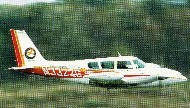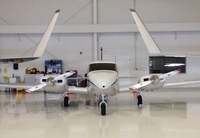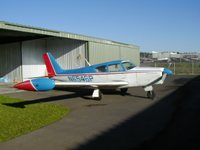Twin Performance Question
38 posts
• Page 1 of 3 • 1, 2, 3
Twin Performance Question
I'm considering trading my 260B for a turbo twin. I need the deice capability and I could use the added altitude the turbos provide. The performance specs I could find on the internet shows a difference between the model B's and C's. The B's show a cruise of 194kts and the C's a 209kts. Why the difference? Is it actual?
- 17031
- ICS member

- Posts: 38
- Joined: Tue Jan 20, 2009 9:44 pm
Re: Twin Performance Question
Not actual. I think Piper just changed the power setting charts. If anything, the B model may be a touch faster than the C model.
Have you found a deiced Twin? Those are rare.
Have you found a deiced Twin? Those are rare.
Kristin
-

Kristin Winter - ICS member

- Posts: 1299
- Joined: Tue Aug 09, 2005 5:21 pm
- Location: Northern California
Re: Twin Performance Question
Ditto Kristin's response.
Biggest single difference between B and C models is a thicker stabilator on the C. After that, so many changes over the years of existence have blurred differences when they came out of the factory ie my 39 sn 10 now has the alt inop lights previously only put on sn 142 and up. Tiny example but indicative of the wide feature variation you will find now.
Be sure to get an experienced Comanche pre-buy and then learn to fly and maintain correctly. See Tech Tab stuff and CFF Tab
Biggest single difference between B and C models is a thicker stabilator on the C. After that, so many changes over the years of existence have blurred differences when they came out of the factory ie my 39 sn 10 now has the alt inop lights previously only put on sn 142 and up. Tiny example but indicative of the wide feature variation you will find now.
Be sure to get an experienced Comanche pre-buy and then learn to fly and maintain correctly. See Tech Tab stuff and CFF Tab
Pat
Patricia Jayne (Pat) Keefer ICS 08899
PA-39 #10 Texas
Patricia Jayne (Pat) Keefer ICS 08899
PA-39 #10 Texas
-

N3322G - ICS member

- Posts: 1911
- Joined: Thu May 08, 2008 1:58 pm
- Location: Fort Worth, Texas area
Re: Twin Performance Question
Keep in mind that turbos will add maintenance expense. You will get some added performance but I've been told by others on this forum that due to engine cooling drag, the turbo models are slower below about 8-9K MSL vs the normally aspirated but faster above. I think the total speed advantage high up may be 10-15 knots or so... I don't have the data to say. But for that little extra speed - you only get it higher up (slower down low) and at added fuel and maint cost. I looked for normally aspirated because I didn't feel the turbos were worth it. Also I've flown my non-turbo PA30 at 11-12K and it performs very well. Zach Grant says the non turbos are even very good at 14K so unless you want to fly high all the time I'd suggest looking normally aspirated. Just my 2-cents.
- Charles
- Charles
-

Charles Schefer - Posts: 563
- Joined: Mon Mar 12, 2012 7:09 pm
Re: Twin Performance Question
Thanks all. The primary reason for the wanting the turbos is for altitude. To reliably get above weather I believe I'll need to get up to 22k or higher. More critical though is the de-icing equipment. There are two weather conditions I stay clear of, thunder storms and icing. I don't take chances with either but I can take the long route around thunder storms. Icing is a different matter. When there is an airmet for icing anywhere on my route I don't fly, period. I occasionally see twins with deicing equipment on the market and if I can find the right one and get it I would get the necessary training and hopefully be good to go. That's my thought process anyway. I am VERY happy with my 260B and having just put in a new 3-blade prop and rebuilt engine, I really would prefer to keep it.
- 17031
- ICS member

- Posts: 38
- Joined: Tue Jan 20, 2009 9:44 pm
Re: Twin Performance Question
Where are you located? The local flying weather can have a big impact on the aircraft needed to dispatch in certain times of the year. If ice is often a big problem big problem in your area and you want to be able to go regularly you need at least a turbo Aztec with all the anti=ice equipment.
Last edited by JIMICS2452 on Thu Dec 24, 2015 6:48 pm, edited 1 time in total.
Jim Hiatt
-

JIMICS2452 - ICS member

- Posts: 254
- Joined: Sat Mar 09, 2002 9:26 pm
- Location: Pine Shadows Airpark - North Fort Myers, FL
Re: Twin Performance Question
Good question Jim. I live in central California, i.e. the central valley. We get most of our moisture for the year in the winter when temperatures can range between 35-60F. At altitude this creates ideal conditions for ice formation. You can check it out yourself by looking at the airmet maps on the AOPA or Aviation Weather Center web sites. In California we get this low lying cloud formation, more like a fog that sits a few hundred feet above the ground. The ceilings are usually only 2000-3000 feet, but you never know for sure and it can get much higher. Coming down through this isn't so bad because I know the ceilings and can see the tops. Last night coming back from LA was a good example. ATC brought me down smack in the middle of hard IFR conditions and as ice began forming I requested a lower altitude and got out of it right away. No problem. Taking off is another matter since I usually don't know the tops. Any ice that does form tends to be very light and if I could get very reliable information on the tops I could make better decisions, i.e. if I knew with certainty the tops were only 2,000 feet for example and only clouds with no precipitation, I know I would have no trouble and could fly with confidence. When it comes to flying maybe I'm too conservative, so under the current circumstances, I drive. (Spending 6 hours, or more, in California traffic for a 3 hour task is no fun.)
- 17031
- ICS member

- Posts: 38
- Joined: Tue Jan 20, 2009 9:44 pm
Re: Twin Performance Question
Ahhh! A fellow Californian.
Your need of some level of icing protection depends a little bit on where you want to go with the plane. If you have a need to cross the Sierras reliably during the winter, then I will second Jim's suggestion. A turbo Aztec is the most capable light twin when it comes to handling ice.
If you missions lie more in trips to SoCal or over to the coast, then a deiced Twinkie will work just fine. The important difference is that the freezing level is rarely so low that you can't shed the ice before landing. The turbo provides some additional capability, but comes with higher maintenance expenses.
BTW, I have a deiced Twinkie. If you want to see the system some time, I am up in Petaluma.
Your need of some level of icing protection depends a little bit on where you want to go with the plane. If you have a need to cross the Sierras reliably during the winter, then I will second Jim's suggestion. A turbo Aztec is the most capable light twin when it comes to handling ice.
If you missions lie more in trips to SoCal or over to the coast, then a deiced Twinkie will work just fine. The important difference is that the freezing level is rarely so low that you can't shed the ice before landing. The turbo provides some additional capability, but comes with higher maintenance expenses.
BTW, I have a deiced Twinkie. If you want to see the system some time, I am up in Petaluma.
Kristin
-

Kristin Winter - ICS member

- Posts: 1299
- Joined: Tue Aug 09, 2005 5:21 pm
- Location: Northern California
Re: Twin Performance Question
Why would a turbo Aztec be any better than a turbo twinkie?
- 17031
- ICS member

- Posts: 38
- Joined: Tue Jan 20, 2009 9:44 pm
Re: Twin Performance Question
The factory turbo system is more robust and more user friendly as it is on all the time. The Aztec has a Cub wing which means it is very high lift and will stay in the air even badly contaminated with ice. It has hot props while the best you can get on a Twin C is alky props.
Kristin
-

Kristin Winter - ICS member

- Posts: 1299
- Joined: Tue Aug 09, 2005 5:21 pm
- Location: Northern California
Re: Twin Performance Question
And an Aztec has another 180 HP to help keep you aloft while you get out of the ice, especially on climb-out. I lived in Vancouver, WA when I bought my Aztec. I needed to cross the Cascade and Rocky mountains on a regular basis, even in the winter. I wanted a Twin Comanche, but after really looking at my requirements a turbo Aztec made more sense. I spent a lot of time sucking oxygen between 15K and 17K cruising above icing conditions.
The biggest downside is the increased fuel burn - 26-28 gph on average from take off to landing, 24-26 gph at cruise.
The biggest downside is the increased fuel burn - 26-28 gph on average from take off to landing, 24-26 gph at cruise.
Jim Hiatt
-

JIMICS2452 - ICS member

- Posts: 254
- Joined: Sat Mar 09, 2002 9:26 pm
- Location: Pine Shadows Airpark - North Fort Myers, FL
Re: Twin Performance Question
Tim,
Sorry if i'm a couple of months late to this conversation. You mentioned your concern and that prior to take off you don't the tops.
"Taking off is another matter since I usually don't know the tops. Any ice that does form tends to be very light and if I could get very reliable information on the tops I could make better decisions, i.e. if I knew with certainty the tops were only 2,000 feet for example and only clouds with no precipitation, I know I would have no trouble and could fly with confidence."
There's many products out there to help determine tops before you go, at any point in time along your route, of course nothing is a guarantee on any flight.
I usually reference area forecasts, airmets (Z), infrared pics and normal nexrad and radar. Dont' forget pireps, get and give. I like skew-T charts too, and even winds aloft and temps. I use a few sites but aviationweather.gov is pretty good, and has a good ice forecast page(s). I'm sure many here have their ways of determining tops.
steve
Sorry if i'm a couple of months late to this conversation. You mentioned your concern and that prior to take off you don't the tops.
"Taking off is another matter since I usually don't know the tops. Any ice that does form tends to be very light and if I could get very reliable information on the tops I could make better decisions, i.e. if I knew with certainty the tops were only 2,000 feet for example and only clouds with no precipitation, I know I would have no trouble and could fly with confidence."
There's many products out there to help determine tops before you go, at any point in time along your route, of course nothing is a guarantee on any flight.
I usually reference area forecasts, airmets (Z), infrared pics and normal nexrad and radar. Dont' forget pireps, get and give. I like skew-T charts too, and even winds aloft and temps. I use a few sites but aviationweather.gov is pretty good, and has a good ice forecast page(s). I'm sure many here have their ways of determining tops.
steve
PA30-1773 N8632Y
-

N8632Y - ICS member

- Posts: 208
- Joined: Wed May 19, 2004 3:56 pm
- Location: N14 South Jersey
Re: Twin Performance Question
Regarding icing - the NOAA ADDS Weather on-line has a predictive icing page that provides a 6+ hour forecast on icing levels and probability at various altitudes. It only looks 6-12 hours ahead but I've found it quite good. Also keep in mind that the deicing or anti-icing options offered on PA-30s (quite rare as Kristin indicated in an earlier post) are not Certificated for Flight Into Known Icing (FIKI). If there is icing forecast having the boots does not make it legal to launch. Nevertheless it's a great help get out of trouble tool to have if you can find one.
- Charles
- Charles
-

Charles Schefer - Posts: 563
- Joined: Mon Mar 12, 2012 7:09 pm
Re: Twin Performance Question
Charles,
Are you saying it is not legal to launch a Comanche into known icing conditions? If so, I am curious about where you find that in the regulations.
Are you saying it is not legal to launch a Comanche into known icing conditions? If so, I am curious about where you find that in the regulations.
Kristin
-

Kristin Winter - ICS member

- Posts: 1299
- Joined: Tue Aug 09, 2005 5:21 pm
- Location: Northern California
Re: Twin Performance Question
Deicing is separated into FIKI and non-FIKI systems. For instance our 2006 Cirrus has a TKS "weeping wing" system but it is not certificated for FIKI. It has to do with the level of testing the manufacturer goes thru. In circa 2009 Cirrus installed a better system and went thru FIKI certification with the FAA. The newest Cirrus is FIKI but only if there is above a certain volume of TKS fluid aboard.
Richard Collins wrote a good piece regarding the FIKI certification of his P210 - Link Here: http://www.flyingmag.com/safety/weather/madness-icing. Some FIKI aircraft - including a C340A I fly recently received a letter from the FAA taking away the FIKI status.
I am quite certain that my understanding of FIKI vs non-FIKI certification standards is correct as I've dealt with the FAA on it quite a bit on the Part 135 charter side. That said, it is only my belief or understanding that the Wiggins de-icing system that was optional on the PA-30 was not FIKI certified. I read somewhere that it was not FIKI. Correct me if I am wrong but the air used to inflate the boots came from a refillable tank in the tail section and not the outflow side of a vaccuum pump or similar. I'd have a hard time believing the FAA would FIKI certify something like that but maybe I am wrong.
I'll try to pull the regulatory references for you on FIKI vs non-FIKI. As far as the PA-30 non-FIKI status goes - I feel confident in my statement but I can't say I am 100% on that.
- Charles
Richard Collins wrote a good piece regarding the FIKI certification of his P210 - Link Here: http://www.flyingmag.com/safety/weather/madness-icing. Some FIKI aircraft - including a C340A I fly recently received a letter from the FAA taking away the FIKI status.
I am quite certain that my understanding of FIKI vs non-FIKI certification standards is correct as I've dealt with the FAA on it quite a bit on the Part 135 charter side. That said, it is only my belief or understanding that the Wiggins de-icing system that was optional on the PA-30 was not FIKI certified. I read somewhere that it was not FIKI. Correct me if I am wrong but the air used to inflate the boots came from a refillable tank in the tail section and not the outflow side of a vaccuum pump or similar. I'd have a hard time believing the FAA would FIKI certify something like that but maybe I am wrong.
I'll try to pull the regulatory references for you on FIKI vs non-FIKI. As far as the PA-30 non-FIKI status goes - I feel confident in my statement but I can't say I am 100% on that.
- Charles
-

Charles Schefer - Posts: 563
- Joined: Mon Mar 12, 2012 7:09 pm
38 posts
• Page 1 of 3 • 1, 2, 3
Return to Maintenance - General
Who is online
Users browsing this forum: No registered users and 14 guests
